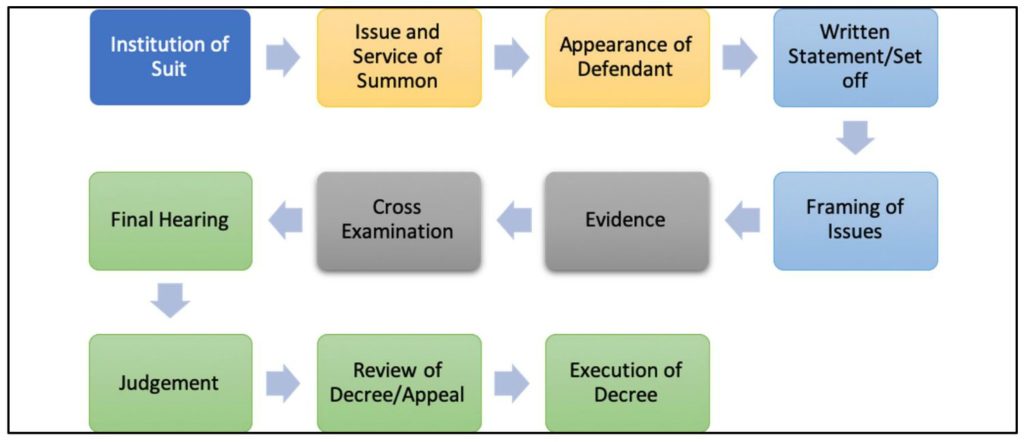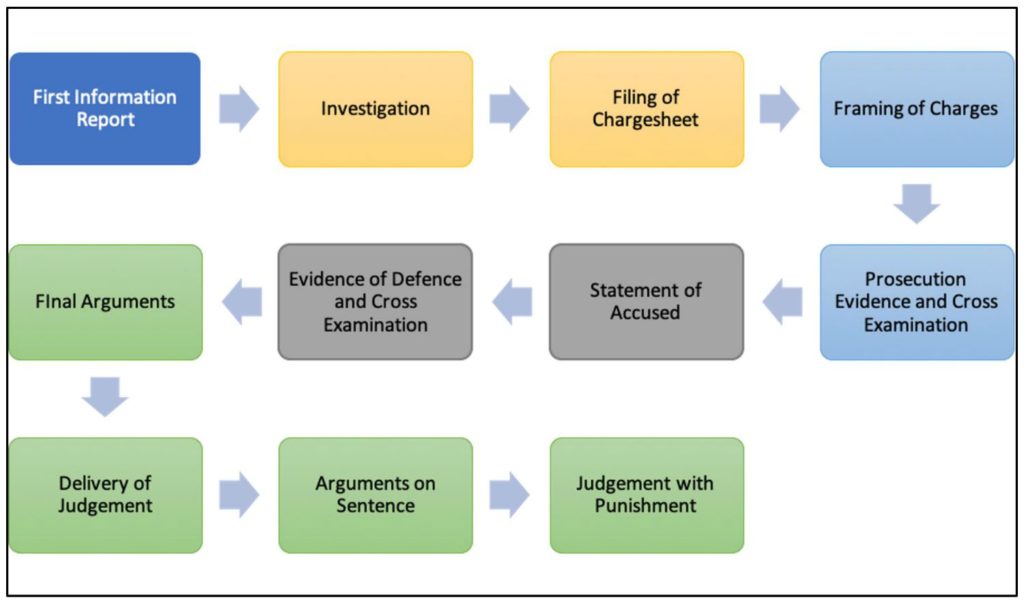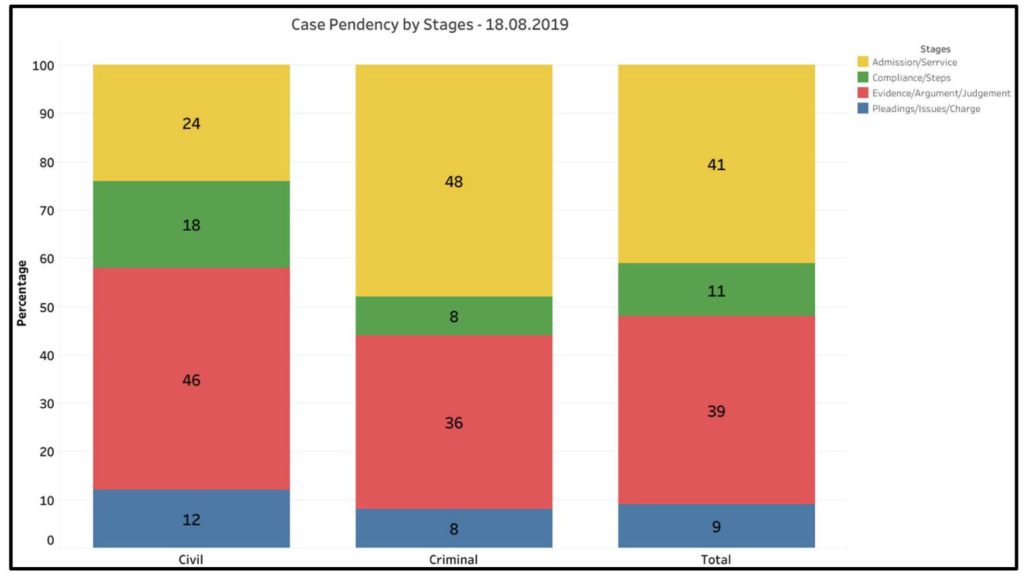[orc]Pendency of court cases is a major issue plaguing the judicial system in India. There are different stages that a civil & criminal case goes through before a judgment is pronounced. Here is a look at the various stages and the pendency at these stages.
Indian judicial system is fraught with a high volume of pending cases. There are nearly 3.1 crore cases pending in District and Taluka Courts of India. Further, nearly 44 Lakh court cases are pending in the high courts. In an earlier article, this issue of pendency of cases in the lower courts was discussed, especially with regards to the age of the cases, reasons for pendency and type of cases that are pending in the courts. The delay in delivering a judgement and to bring a closure to the case, has a great bearing on the efficacy of the justice system in India.
Apart from the reasons for the pendency in courts, understanding the various stages of the court proceedings and identifying the bottle necks would help focus on specific issues. In this story, the typical flow of civil & criminal cases is discussed along with the stages at which the cases are stuck as per data available on the National Judicial Data Grid (NJDG) portal.
Stages of Court Proceedings vary with the type of Case
There are various types of Civil and Criminal cases that are filed in courts based on the type of court. These could be writ petitions, appeals, special leave petitions etc.
The Civil case
A typical process flow of a civil case would be like in the following illustration.

The civil case is initiated by a person or entity (referred to as Plaintiff), when they feel that a legal obligation is not met by another person or an entity (referred to as Defendant). The court after reviewing the suit filed, issues a summon for the defendant to appear in front of the court. The Defendant can defend their case against the evidence presented (written statement stage). When there is a difference between the claims of the plaintiff and the defendant, an issue arises. In further stages of the proceedings, evidence is collected and submitted in the court, which is cross-examined.
After the cross examination, there would be further hearing in court. The Judge, based on the evidence presented and the facts of the case can proceed with the judgement. The parties involved in the Civil case have an option to appeal the judgement in higher courts, else the case comes to a closure with execution of the decree provided by the court.
The Criminal Case
The flow of proceedings in a criminal case varies from a Civil case and is illustrated in the following diagram.

Filing a First Information Report (F.I.R) initiates a criminal case. The Law enforcement authorities are required to carry on an investigation in view of the F.I.R. A charge sheet is then filed against the accused. If there is substantial evidence proving that the accused has committed a crime, the charges are framed. The evidence is presented by the prosecution in the court of law, which can be cross examined by the advocates of the accused. The statement of the accused is taken, which is the account of the accused in light of the evidence being presented against.
This statement along with any new evidence provided by the Defence is cross examined. After further trial and arguments in the court, the judge can proceed to deliver the judgement. The sentence can be argued upon. The judge hears these arguments and can revise the punishment after which the final judgment with the Punishment is delivered. Even in a criminal case, the accused has an option to approach the higher courts with an appeal.
While the process looks pretty straight forward, there are multiple stages in between wherein the cases get stalled for a longer period of time or it involves back and forth movement of the cases between multiple stages.
Collection of evidence and Appearance in court are the stages with the highest pendency
Data as per NJDG (National Judicial Data Grid) portal shows that nearly 39% of the total cases (Civil and Criminal) are pending at the Evidence/Hearing stage of the case. While another 41% of the cases are stuck in the initial stages (Appearance, Service of notice etc.).
In the civil cases, a major portion of pendency (46%) is in the stage of Court hearings which includes – collection and presentation of the evidence, the arguments for and against the case filed etc. Of all the cases that are pending at this stage, nearly 39% of the cases are pending for evidence. Civil cases are filed by a person or entity, stating that another person or entity has not complied with the law. However, as the numbers indicate, a good portion of them remain pending for lack of substantial evidence. Another 39% of the cases pending at this stage are due to delays with Court Hearing. High number of pending cases causes delays in securing a court hearing, and as highlighted earlier, lack of evidence or objections regarding the evidence would result in postponement of the court hearing to a later date.
Apart from 24% of the total civil cases pending in the initial stages, a further 18% of the cases are pending due to issues with compliance and the steps involved.
In pending criminal cases, nearly 48% are pending in the initial stages of – Appearance and Service. Within this, nearly 57% of the cases are pending due to non-appearance of the parties in the court. Mistakes in the court notices (date of hearing, time etc.), delays in travel, ill-health, mistakes by attorney, counsel being busy in other courts are cited as reasons for the non-appearance of the defendants.
Among the pending criminal cases, nearly 36% of the cases are pending at the trial stages (Evidence, Argument & Judgement). Approximately 61% at this stage are pending due to lack of substantial evidence. Another 13% of the cases are pending at the hearing stage, wherein arguments are made by counsel of the parties involved.

Lack of support mechanism and excessive workload on the judge main causes for pendency in cases.
Legal experts have cited various reasons for pendency in court cases at different stages.
- The number of judges to population ratio in India is very low. The current number of judges is less than half the recommendation of law commission. It had recommended 50 judges per million of population. India currently has around 20 judges per million people. On the other hand, USA has around 100 per million, China – 160, Sweden-125, Germany- 250 etc. This results in delays in securing a date for hearing as could be seen in the high number of cases pending in initial as well as court hearing stages.
- Efficiency and reliability of the support system like law enforcement agencies, which take the responsibility of filing charges, securing evidence etc. is also a major reason for pendency. As the data indicates, a major portion of the cases are pending due to lack of substantial evidence.
- The legal process is riddled with complex procedures along with ambiguous laws open for interpretation. Many of the cases are pending at compliance due to the complex steps involved at every stage. The sheer volume of the case files requires the judge to invest effort and time in going through each of them before pronouncing a judgement, which in turn causes delays in the final stages of a case.
Featured Image: Cases pending in Indian courts



2 Comments
Come to Vanur munsif, Villupuram,RN. The Judge arrives after 3 o clock, only 2 or 3 times a week. Then without his black coat, sits at the liars table, goes through 4 or 5 files, then returns home. Parks his car 2 inches from the door, so you have to slide past it to enter. The clerks want money and take it inside the court room. Lawyers use the phone, watch videos and chat through the hearings.
How does one expect cases to be concluded.
Emails to every address on every ecourt site remains unanswered, as did the one to the Law Minister
Most cases are adjourned because of lack of interest of the parties specially the opposite party. They continue to procrastinate for filing replies or providing evidence and Judge keep adjourning the case. 2 years can get passed easily due to adjournments. Cases run at speed of a snail. Source: I work in courts.